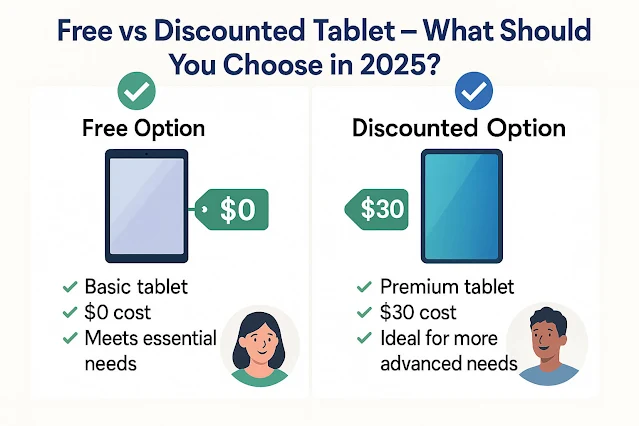Introduction: A Tablet That Changed Two Lives
In a small town in West Virginia, 14-year-old Clara spends evenings hunched over her family’s shared smartphone, squinting to complete algebra homework. Meanwhile, 72-year-old George, a retired veteran in Arizona, hasn’t seen his grandkids in months because he can’t figure out video calls on his flip phone.
Their stories shifted dramatically in 2025 when Clara qualified for a free Samsung Galaxy Tab A7 through the Affordable Connectivity Program (ACP), while George received a Lenovo Tab M8 via Lifeline. Now, Clara streams virtual chemistry labs and George attends telehealth appointments—all from devices that cost them nothing.
These tablets, distributed through ACP, Lifeline, and state initiatives, are more than gadgets—they’re lifelines. You can apply today using this free tablet eligibility tool to see if you qualify.
Why Tablets Are a Game-Changer for Students
1. Access to Online Classes and Homework
In 2025, 83% of U.S. schools use digital textbooks and online portals for assignments. Without a tablet, students like Clara risk falling behind. Free tablets enable:
Virtual classrooms (Zoom, Google Meet).
Homework submission via platforms like Canvas or Google Classroom.
Collaboration tools for group projects (Microsoft Teams, Slack).
2. Digital Libraries and Learning Resources
Tablets unlock free educational content:
E-books: Platforms like Libby or OverDrive offer library books for free.
YouTube tutorials: Channels like Khan Academy simplify complex topics.
Learning apps: Duolingo for languages, Photomath for equations.
3. Portability and Affordability
Unlike bulky laptops, tablets are:
Lightweight: Fits in backpacks for school or libraries.
Long battery life: 10+ hours for all-day use.
Cost-effective: Families save 500 on device costs.
The FCC reports that 1 in 3 low-income students lacked adequate tech for remote learning in 2024. Programs like ACP aim to close this gap.
How Free Tablets Transform Lives for Seniors
1. Telehealth Appointments from Home
For seniors with mobility issues or chronic conditions, tablets enable:
Virtual doctor visits (Teladoc, Amwell).
Prescription management via Walmart Pharmacy or PillPack apps.
Remote monitoring for conditions like diabetes (Dexcom, MySugar).
2. Staying Connected with Family
Tablets bridge generational gaps:
Video calls: FaceTime, WhatsApp, or Skype for grandparent-grandkid chats.
Social media: Facebook or Instagram to share memories.
Email and messaging: Quick updates without phone calls.
3. Entertainment and Mental Stimulation
From streaming to brain games, tablets offer:
Entertainment: YouTube, Netflix, or free library movie rentals.
News access: Stay updated via The New York Times or local news apps.
Games: Puzzles, Sudoku, or Words With Friends to sharpen cognition.
4. Accessibility Features
Modern tablets include senior-friendly tools:
Text enlargement: Adjust font sizes for easier reading.
Voice commands: Use Siri or Google Assistant hands-free.
Hearing aid compatibility: Pair devices via Bluetooth.
Government Programs Offering Free Tablets in 2025
1. Affordable Connectivity Program (ACP)
Though ACP’s federal funding ended in 2024, many states have extended it locally. Benefits include:
Discounted tablets: 50 co-pay for devices like the Alcatel Joy Tab.
Internet subsidies: $30/month toward home Wi-Fi.
Eligibility: Medicaid, SNAP, or income ≤200% Federal Poverty Level.
2. Lifeline Assistance
Lifeline focuses on connectivity but partners with providers like Q Link Wireless to offer:
Free tablets: Basic models for qualifying seniors and students.
Bundled services: Data plans with unlimited talk/text.
3. FreeTabletGovt.com
This platform simplifies the process by:
Matching applicants to state/local programs.
Providing step-by-step guides for ACP and Lifeline.
👉 FreeTabletGovt.com connects both students and seniors to verified free tablet programs.
Which Tablets Are Typically Provided?
| Model | Best For | Key Features | Co-Pay |
|---|---|---|---|
| Samsung Galaxy Tab A7 | Students | 10.4” screen, 32GB storage, Kids Mode | 30 |
| Lenovo Tab M8 | Seniors | 8” HD display, lightweight, long battery | 15 |
| Alcatel Joy Tab 2 | Budget users | 8” screen, 4G LTE connectivity | $10.01 |
| Amazon Fire HD 10 | Multimedia | 10.1” screen, Alexa hands-free | $49.99 |
Note: Co-pays vary by provider and state. Some nonprofits like PCs for People waive fees entirely.
Success Stories: Real Impact of Free Tablets
Clara’s STEM Breakthrough (Rural Kentucky)
Clara, a high school sophomore, received a free Lenovo Tab M8 through her school’s ACP partnership. She now attends virtual STEM workshops hosted by MIT, something her rural school couldn’t offer. “I’m coding my first app,” she says. “This tablet opened doors I didn’t know existed.”
George’s Health Turnaround (Louisiana)
After a heart attack, George struggled to attend follow-ups. His Lifeline-provided Samsung tablet lets him consult cardiologists via telehealth. “My doctor noticed a red flag in my last video visit,” he shares. “This thing saved my life.”
Tips for Maximizing Your Free Tablet
For Students
Top Apps: Khan Academy, Quizlet, Google Drive.
Free Wi-Fi: Use FCC’s Wi-Fi Finder Map to locate hotspots.
Security: Enable parental controls and VPNs on public networks.
For Seniors
Health Apps: MyChart (medical records), Medisafe (pill reminders).
Safety: Install antivirus software (Avast, Bitdefender).
Tutorials: Visit local libraries for free tech workshops.
How to Apply Without Hassle
Check Eligibility: Confirm income or program participation (Medicaid, SSI).
Gather Documents: ID, benefit letter, proof of address.
Choose a Provider: Use FreeTabletGovt.com to compare options.
Submit Application: Apply online, by mail, or at community centers.
Pro Tip: Avoid rejection by ensuring documents are current and addresses match.
Final Call to Action: Claim Your Tablet Today
Whether you’re a student striving for academic success or a senior seeking connection and care, a free tablet can redefine your daily life. Programs are available now—but demand is soaring.
👉 Start your application here to access:
Trusted provider listings.
Eligibility verification tools.
Real-time application tracking.
For more tips, visit our Free Tablet Help Blog.






